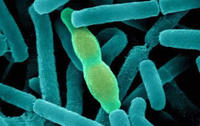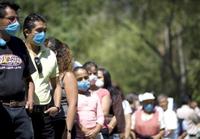-
Magnetic "nanobeads" detect chemical and biological agents
Researchers at Oregon State University have found a way to use magnetic “nanobeads” to help detect chemical and biological agents, with possible applications in everything from bioterrorism to medical diagnostics, environmental monitoring, or even water and food safety; rapid detection of chemical toxins used in bioterrorism would be possible, including such concerns as anthrax, ricin or smallpox, where immediate, accurate and highly sensitive tests would be needed
-
-
Social media helps CDC track Playboy Mansion disease outbreak

Thanks to social media outlets, medical researchers are one step closer to discovering why more than 120 people were infected with a mysterious illness following a 3 February party at the Playboy Mansion; investigators suspect that the bacteria that causes Legionnaires’ disease may have been the source of the outbreak after its presence was discovered in the grotto of the Playboy Mansion; officials used online tools like Twitter, Facebook, and online polling to help track the disease outbreak; these tools were particularly helpful because they allowed officials to quickly identify the outbreak, communicate quickly with conference goers who came from thirty countries, and to issue instructions for the infected
-
-
California schools struggle to vaccinate millions against whooping cough
After experiencing its worst whooping cough outbreak in more than six decades, California is taking extra precautions to ensure that children are vaccinated against the preventable disease; California lawmakers mandated that all children entering the seventh grade and up must have a whooping cough booster vaccine; but parents and school districts are still scrambling to get children vaccinated before the Fall when students will be prohibited from entering a classroom without it; nearly three million students must be vaccinated making it a logistical nightmare for schools to process paperwork; in 2010, there were than 7,800 cases of whooping cough and the disease claimed the lives of ten children
-
-
Promising anthrax treatment study results

Researchers find that a multi-agent prophylaxis which is initiated within twenty-four hours after the infection, prevented the development of fatal anthrax respiratory disease; treatment which combines antibiotics with immunization and a protective antigen-based vaccine offered long-term immunity against the disease
-
-
Information sharing seen as public health "game changer"

Public health officials are pushing for the creation of shared databases that contain electronic health records (EHRs) to help combat infectious diseases and stop epidemics; a CDC official pointed to the positive impact that electronic health information exchanges (HIE) have on public health; during the 2003 SARS outbreak, Milwaukee helped establish a four-state network that automatically detected new cases of SARS based on electronic reports from local hospital emergency rooms; manual reporting of test results is a slow process, but with the use of electronic reporting public health officials can now quickly identify epidemics and pandemics as they occur
-
-
Easing contamination fears in Japan's food industry

With much of Japan’s manufacturing sector, land, and critical infrastructure badly damaged from the March 11 earthquake and tsunami, dairy and rice manufacturers have struggled to produce enough to feed the nation; Japan produces all of its own milk, rice, and yogurt products, but domestic plants are operating far below full capacity; shortages may persist into the summer; as production ramps up, fears of contamination from radiation leaked from the Fukushima Daiichi nuclear power plant may dampen consumption; one analyst suggests that Japan institute a food tracking program that will allow consumers to track the production of food every step of the way to help ease fears
-
-
Drug resistant salmonella found in recalled turkey burgers

Last week the Centers for Disease Control and Prevention (CDC) announced that investigators have determined that ground Jennie-O turkey burgers have been contaminated with a drug resistant strain of Salmonella; the infection from the contaminated burgers was first detected on 27 December 2010 and has infected twelve people in ten states; a recall has been issued for nearly twenty-seven tons of the infected burgers; the Hadar strain of Salmonella, is resistant to most antibiotics complicating treatment options and increasing the chances of hospitalization; CDC investigators say they are still examining the case and may issue further recalls on raw turkey products
-
-
Nine die in Alabama from infected IVs

Alabama public health officials are currently investigating the deaths of nine patients who received intravenous nutrition from contaminated feedbags; officials say that the intravenous nutrition solution, called total parenteral nutrition (TPN), contained Serratia marcescens bacteremia, which leads to a bacterial infection in the blood; investigators have traced the source of the contaminated intravenous nutrition feed bags to the pharmaceutical supplier Meds IV; the bacteria is commonly found and it is difficult to specifically link the organisms that killed the nine patients to those found at Meds IV facility
-
-
Information about Maryland biolabs scarce
High-level containment laboratories and storage facilities that handle dangerous biological agents exist in Frederick County, Maryland, outside the secured gates of Fort Detrick, but state law mandates that the number and location of each remains confidential; supporters of the current system say that confidentiality is critical to maintain the security and safety of the labs, but critics argue that the secrecy makes it impossible for emergency services in the neighborhood to prepare properly for accidents
-
-
Full-body scanners not a health risk
A new study concludes that there is “no significant threat” from backscatter X-ray scanners; even though they use ionizing radiation, which is known to cause cancer, the doses are so low — less than 1 percent of the additional radiation a person gets from flying in an airplane in the first place, and about the same received through 3 to 9 minutes of daily life on the ground — that only a handful of cancer cases are likely to result directly from scanner use
-
-
Satellite information helps eradicate mosquitoes
Louisiana’s St. Tammany Parish is partnering with Colorado-based location intelligence software company aWhere, Inc. to test a new satellite-based surveillance system that can locate and analyze potential mosquito breeding sites with near pinpoint accuracy
-
-
Starving bugs dead
One way to kill bugs and pests is to starve them to death; caterpillars attack tomato and potato plant in order to extract an enzyme called threonine, or TD1 — a key nutrient caterpillars need to grow; Michigan State University researchers show that the potato and tomato plants release an enzyme — called TD2 — which caterpillars consume at the same time they consume TD1; TD2 has devastating effects a few hours later — in the pests’ stomachs; TD2 goes to work in the gut of caterpillars to degrade TD1; in effect, the plants concede the first battle — allowing caterpillars to consume as much TD1 (but also TD2) as they wish — in order to win the war (the caterpillars will be dead within a few hours)
-
-
Superbug sweeps across Los Angeles hospitals
Last week, public health officials in Los Angeles reported an outbreak of a drug-resistant superbug in several local healthcare facilities; the deadly drug-resistant strain is Klebsiella pneumonia (CRKP) and is estimated to kill 40 percent of those who are infected with it; the LA county health department has identified 356 cases of the bacteria over a six month period; CRKP has primarily been infecting senior citizens; CRKP is part of a larger wave of antibiotic germs that have plagued hospitals in recent years; the bacteria was originally found on the east coast of the United States, and was only first seen last year in the Los Angeles area
-
-
Canada launches TB website to stem spread of disease
Researchers at Canada’s McGill University recently launched a free website to help doctors around the world stem the spread of tuberculosis (TB); the website offers detailed information on TB vaccinations in over 180 countries; while TB levels are at all-time lows in Canada and the United States, TB has grown increasingly prevalent around the world particularly in Africa and India; in India, there are nearly two million new cases of TB each year and it is the leading cause of death among people between the ages of fifteen and forty-five; the International Federation of Red Cross and Red Crescent Studies recently warned that up to ten million people could die of TB by 2015; if detected early, TB can be treated with antibiotics
-
-
Australia battling mosquitoes to stop spread of dengue fever

Public health officials in Queensland in northern Australia are actively battling dengue fever following an outbreak of the virus; fifty-five people have been infected in Innisfail and its outlying areas; two cases of dengue fever have been detected in Cairns, 56 miles north of Innisfail; to stem the spread of the disease, public health officials are on a campaign to eradicate mosquitos and their breeding grounds; so far the government has wiped out an estimated 50,000 mosquito breeding sites; in one week, fourteen public health field officers searched 1,117 properties in Innisfail and found 13,628 potential breeding sites
-
More headlines
The long view
We Ran the C.D.C.: Kennedy Is Endangering Every American’s Health
Nine former leaders of the Centers for Disease Control and Prevention (CDC), who served as directors or acting directors under Republican and Democratic administrations, serving under presidents from Jimmy Carter to Donald Trrump, argue that HHS Secretary Roert F. Kennedy Jr. poses a clear and present danger to the health of Americans. He has placed anti-vaxxers and conspiracy theorists at top HHS positions, and he appears to be guided by a hostility to science and a belief in bizarre, unscientific approaches to public health.
